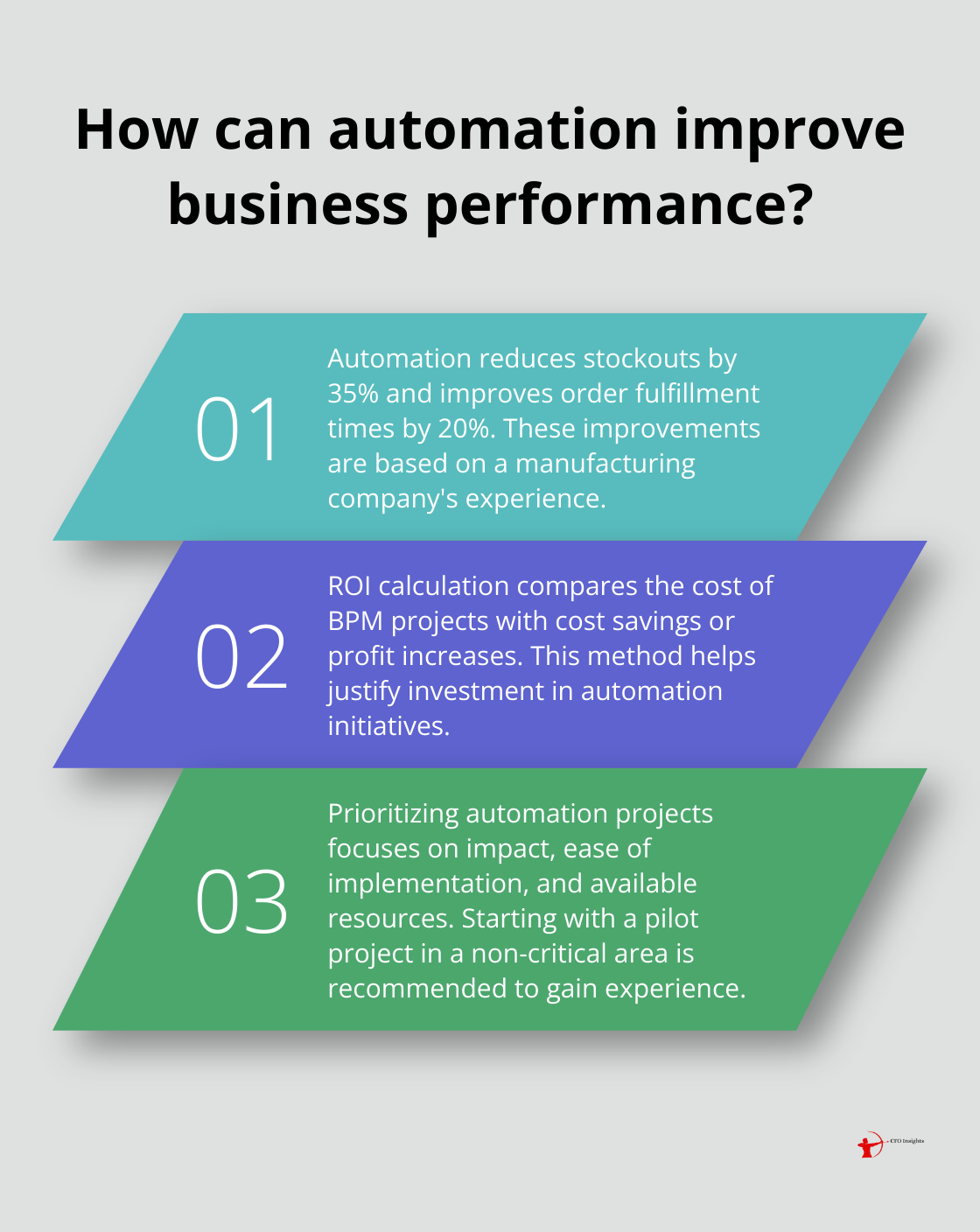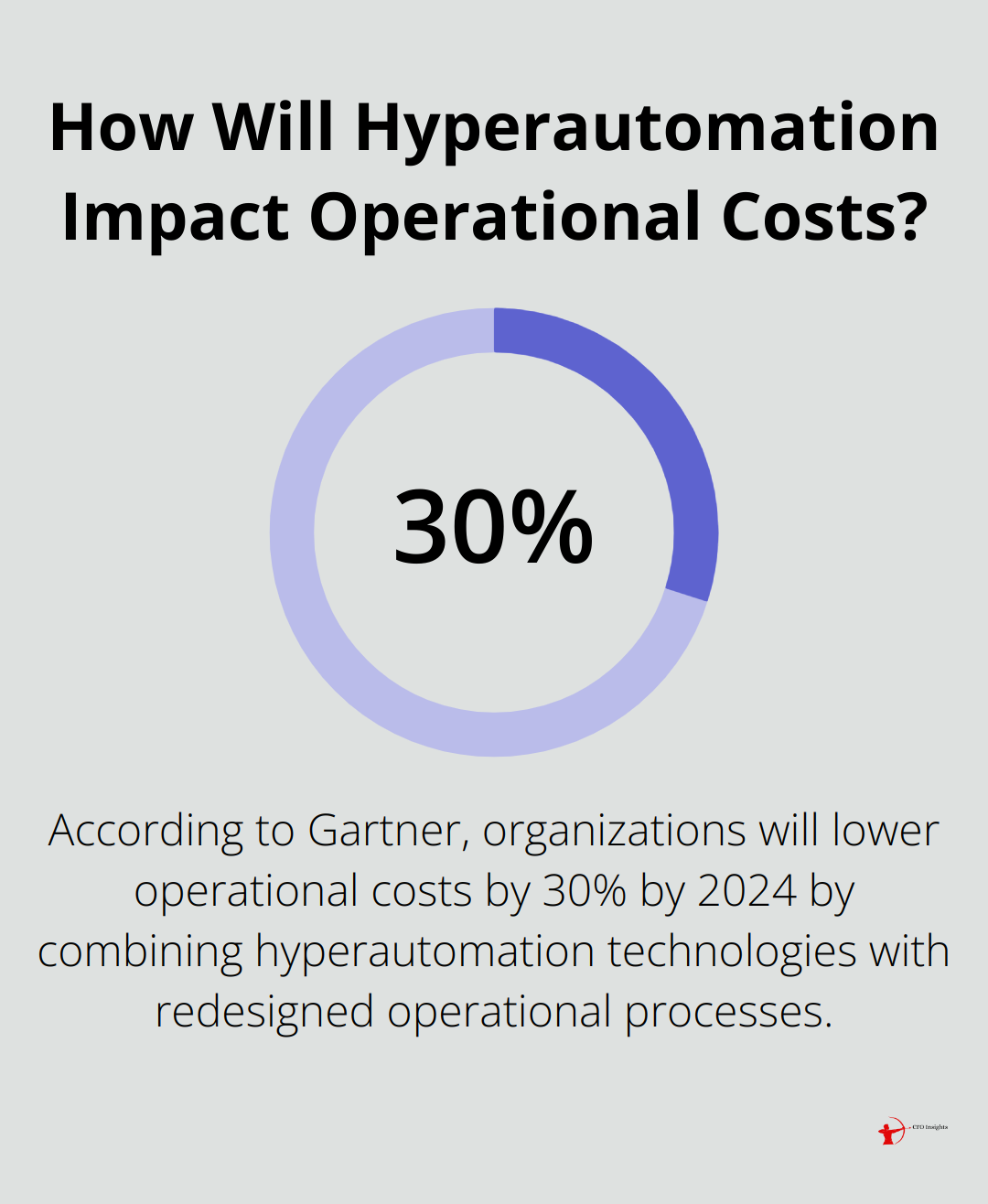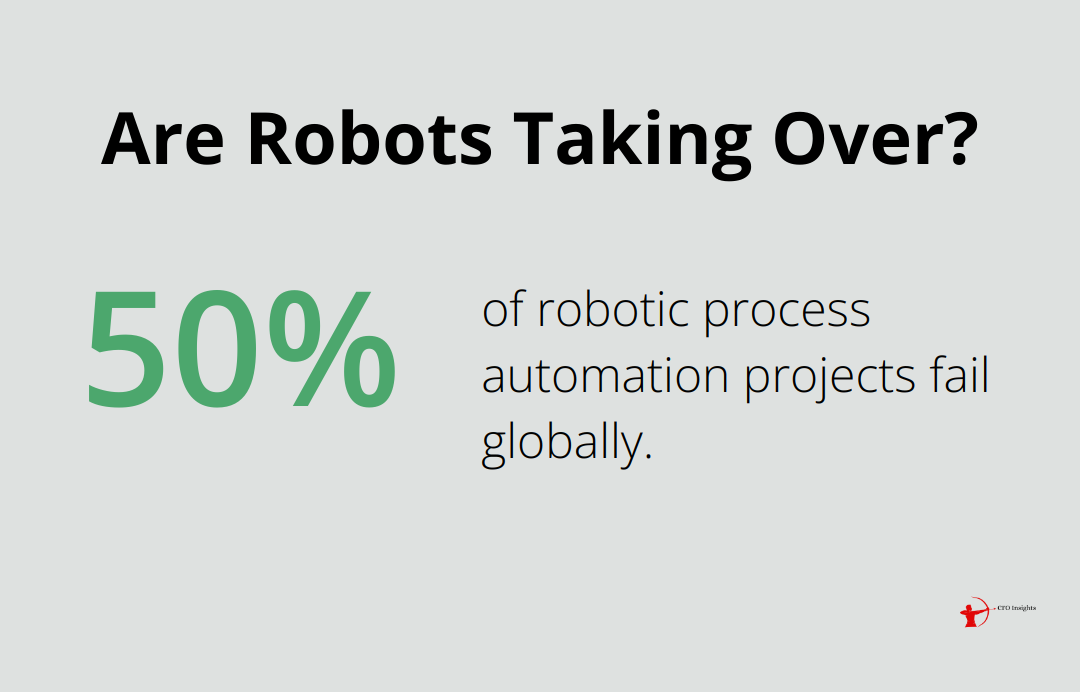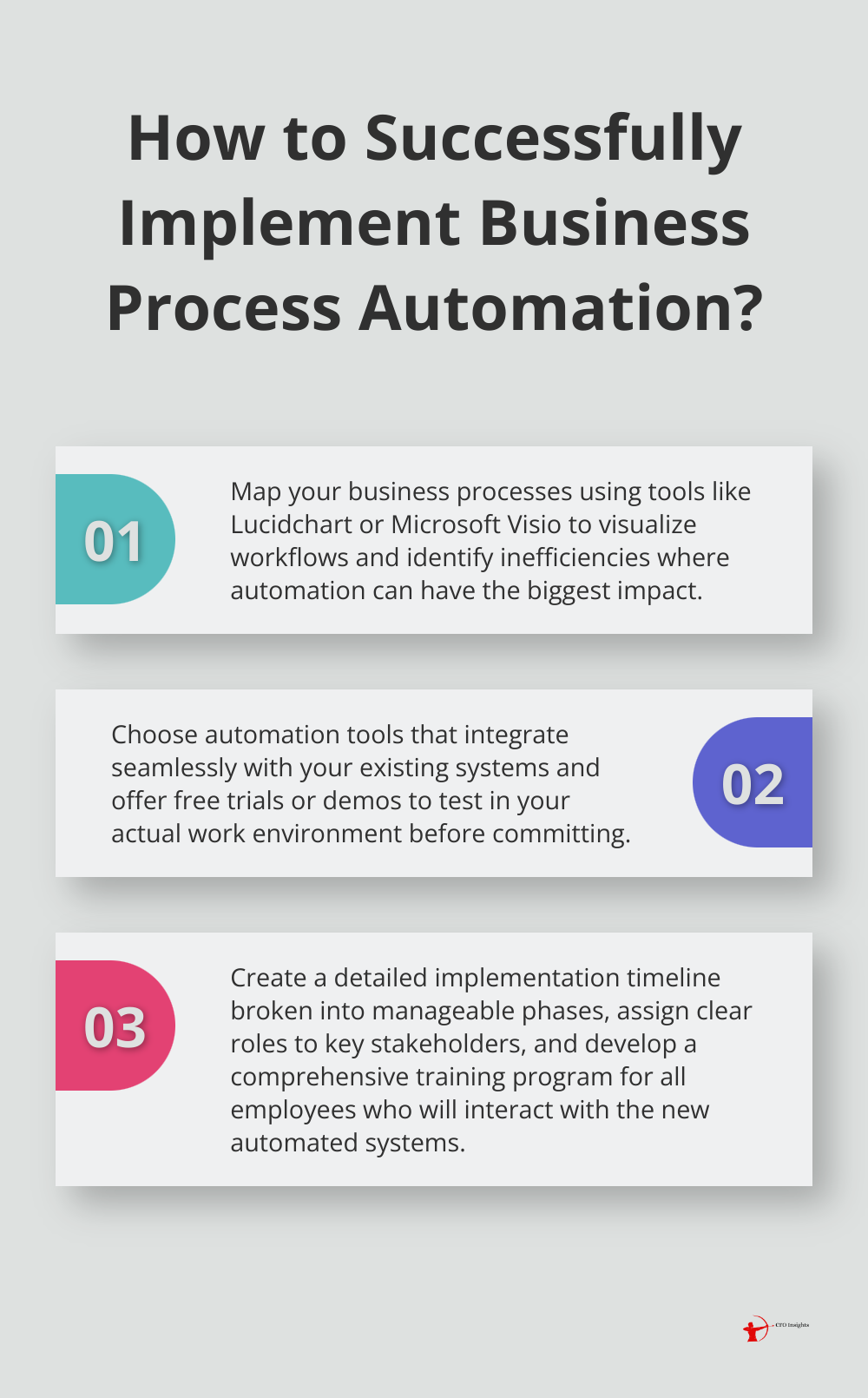Strategic automation is revolutionizing how companies operate, boosting efficiency and cutting costs. At CFO Insights, we’ve seen firsthand the transformative power of well-implemented automation strategies.
This guide will walk you through the essential steps to successfully introduce automation in your organization. From assessing your needs to choosing the right tools, we’ll provide practical advice to help you navigate this critical process.
Assessing Your Company’s Automation Needs
Map Your Business Processes
The first step in implementing a successful automation strategy is to create a comprehensive map of your business processes. This involves documenting every step in your workflows, from customer acquisition to product delivery and financial reporting. Tools like Lucidchart or Microsoft Visio can help visualize these workflows. This exercise often reveals surprising insights about how your business actually operates.
Spot Inefficiencies and Bottlenecks
Once you have a clear picture of your processes, identify where automation can have the biggest impact. Look for tasks that are:
- Repetitive and time-consuming
- Prone to human error
- Causing delays or bottlenecks
- Requiring significant manual data entry

For example, a manufacturing company discovered that their inventory management process caused significant delays. Automating this process reduced stockouts by 35% and improved order fulfillment times by 20%.
Calculate Potential ROI
To justify the investment in automation, quantify its potential benefits. This involves estimating:
- Time saved per task
- Reduction in errors and associated costs
- Potential increase in output or capacity
- Labor costs that could be reallocated to higher-value activities
To calculate the direct ROI on any given BPM project, the cost of the BPM project is compared with any cost savings made or increases in profit.
Prioritize Automation Opportunities
Not all processes that can be automated should be automated immediately. Prioritizing process automation projects ensures you can deliver value, reduce operational costs and improve productivity. Consider:
- Potential impact on business goals
- Ease of implementation
- Available resources and budget
We recommend starting with a pilot project in a non-critical area to build confidence and gain experience with automation technologies.
The goal of automation isn’t just to reduce costs (although that’s often a significant benefit). It’s about improving overall business performance. A careful assessment of your needs will ensure that your automation strategy aligns with your broader business objectives and delivers tangible value.
Now that you’ve identified your automation needs, it’s time to explore the tools and technologies that can bring your strategy to life. In the next section, we’ll discuss how to choose the right automation solutions for your company.
Selecting the Best Automation Tools
Assess Your Technical Requirements
The first step in choosing automation tools is to list the specific features your solution must have. These could include data integration capabilities, user-friendly interfaces, or advanced analytics. For example, if you plan to automate financial processes, you need tools that can handle complex calculations and comply with accounting standards.

The global RPA market was valued at $5.63 billion in 2023 and is expected to reach $54.57 billion by 2032 at a yearly growth rate of 28.7%. This trend underscores the importance of choosing tools that can grow with your business.
Evaluate Vendor Reputation and Support
Look beyond the software itself to the company behind it. Research potential vendors thoroughly. Check their track record, financial stability, and customer support quality. A tool from a reputable vendor with excellent support can save you countless headaches down the line.
According to Gartner, organizations will lower operational costs by 30% by 2024 by combining hyperautomation technologies with redesigned operational processes. This statistic highlights the potential impact of choosing the right tools.
Test Drive Before Committing
Most reputable vendors offer free trials or demos of their automation tools. Take advantage of these opportunities to test the software in your actual work environment. Involve key stakeholders in this process to ensure the tool meets everyone’s needs.
Consider Integration and Scalability
The automation tools you select should integrate seamlessly with your existing systems. This integration ensures smooth data flow and prevents the creation of new silos. Additionally, choose tools that can scale with your business (as your needs grow and change over time).
Prioritize User-Friendliness
The success of your automation initiative depends largely on user adoption. Select tools with intuitive interfaces that your team can quickly learn and use effectively. HR software can help to optimize employee onboarding by making it more transparent and less time-consuming for HR and the new employee.
The next step in your automation journey involves creating a solid implementation plan. This plan will guide your efforts and ensure a smooth transition to your new automated processes.
How to Create an Effective Automation Implementation Plan
Set Clear, Measurable Goals
Your automation project should start with specific, measurable objectives that align with your overall business strategy. For example, if you automate your accounts payable process, you might aim to reduce invoice processing time by 50% within six months. Implementing intelligent automation can have a positive influence on business process performance, as suggested by various studies.
Develop a Realistic Timeline and Budget
Create a detailed timeline for your automation project. Break it down into manageable phases. Account for potential setbacks and allow time for testing and refinement. A study by Ernst & Young found that 30% to 50% of robotic process automation projects fail globally, so it’s important to be conservative in your estimates.

For budgeting, consider all costs associated with the project (including software licenses, hardware upgrades, training, and potential productivity dips during the transition period).
Assign Clear Roles and Responsibilities
Identify key stakeholders and define their roles in the automation project. This typically includes:
- An executive sponsor to champion the project at the leadership level
- A project manager to oversee day-to-day implementation
- IT staff to handle technical aspects
- End-users who will work with the automated systems
Clear role assignment ensures accountability and smooth project progression. A McKinsey report found that there are 21 best practices that make a digital transformation more likely to succeed.
Involve Your Team Early
Successful automation implementation is not just about technology-it’s about people and processes too. Involve your team early in the planning process to gain buy-in and valuable insights. This approach can significantly boost the chances of your automation project’s success.
Plan for Training and Change Management
Prepare a comprehensive training program for all employees who will interact with the new automated systems. This should include both technical training on how to use the new tools and broader education on the benefits of automation for the company. A well-planned change management strategy can help overcome resistance and ensure smooth adoption of new processes.
Final Thoughts
Strategic automation transforms business processes, driving efficiency and growth. Companies that implement automation successfully often experience significant improvements in productivity and cost reduction. This approach frees up teams to focus on higher-value tasks, which fosters innovation and creativity within organizations.

A proactive approach to automation will keep your company competitive in an increasingly digital business landscape. We at CFO Insights understand the complexities of implementing strategic automation and can guide you through every step of the process. Our team of experienced professionals offers fractional CFO services that provide the financial expertise needed to make informed decisions about automation investments.
Strategic automation positions your company for future success (the time to start is now). You can take the first step towards a more efficient, productive, and competitive business by exploring how automation can transform your company. Our team stands ready to help you navigate this important transition and unlock the full potential of your business through strategic automation.
One thought on “How to Implement Strategic Automation in Your Company”
Leave a Reply
You must be logged in to post a comment.





[…] CFO Insights also delves into the topic of strategic automation in companies. The article “How to Implement Strategic Automation in Your Company” provides valuable insights on how businesses can effectively incorporate automation into […]